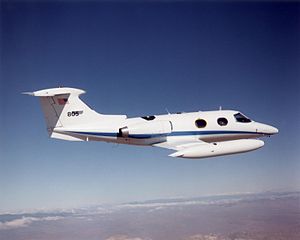Learjet 24
| Learjet 24 | |
|---|---|
 |
|
| NASA Learjet 24 | |
| Role | Business jet |
| Manufacturer | Learjet |
| First flight | January 24, 1966 |
| Introduction | November 9, 1966 |
| Status | Active |
| Primary users | Private Military NASA |
| Produced | 1966-1977 |
| Number built | 259 |
The Learjet 24 is an American six-to-eight-seat (two crew and four to six passengers) twin-engine, high-speed business jet, which was manufactured by Learjet as the successor to the Learjet 23.
The Learjet 24 was designed as an improved version of the Learjet 23, which was limited to 12,500 pounds (5,700 kg) gross weight. Engineers designed the model 24 to accept up to the full 13,500 pounds (6,100 kg) gross weight permitted by FAR-25 standards.
Other improvements introduced in the Learjet 24 included:
With these changes, the LJ24 became the first business jet to be certified under FAR-25.
The first flight of a Learjet 24 took place on January 24, 1966. From May 23 to 26, 1966, a Learjet 24 flew around the world in 50 hours and 20 minutes flying time as a demonstration of its capabilities. Different variants were the 24A, B, C, D, E and F, with changes of takeoff weight, in-fuselage fuel tank, range, cabin and engines.
Altogether 259 Model 24s were built, and in 2001, there were still 210 Learjet 24s in use. Thirty-nine LJ24s have been lost through accidents.
In 2013, the FAA modified 14 CFR part 91 rules to prohibit the operation of jets weighing 75,000 pounds or less that are not stage 3 noise compliant after December 31, 2015. The Learjet 24 is listed explicitly in Federal Register 78 FR 39576. Any Learjet 24s that have not been modified by installing Stage 3 noise compliant engines or have not had "hushkits" installed for non-compliant engines will not be permitted to fly in the contiguous 48 states after December 31, 2015. 14 CFR §91.883 Special flight authorizations for jet airplanes weighing 75,000 pounds or less - lists special flight authorizations that may be granted for operation after December 31, 2015.
Standard version. Converted from existing Learjet 23. Takeoff weight 13,499 pounds (6,123 kg). FAA certified on November 9, 1966. 81 aircraft built.
Improved variant, powered by two 2,950 lbf (13.1 kN) thrust General Electric CJ610-6 turbojet engines, and 13,499 pounds (6,123 kg) maximum take-off weight. FAA certified December 17, 1968. 49 aircraft built.
A light-weight version of the 24B, fuselage tank not fitted which would have caused a reduction in range. The Learjet 24C project was abandoned in December 1970. Take-off weight 5,675 kilograms (12,511 lb). None built.
...
Wikipedia
